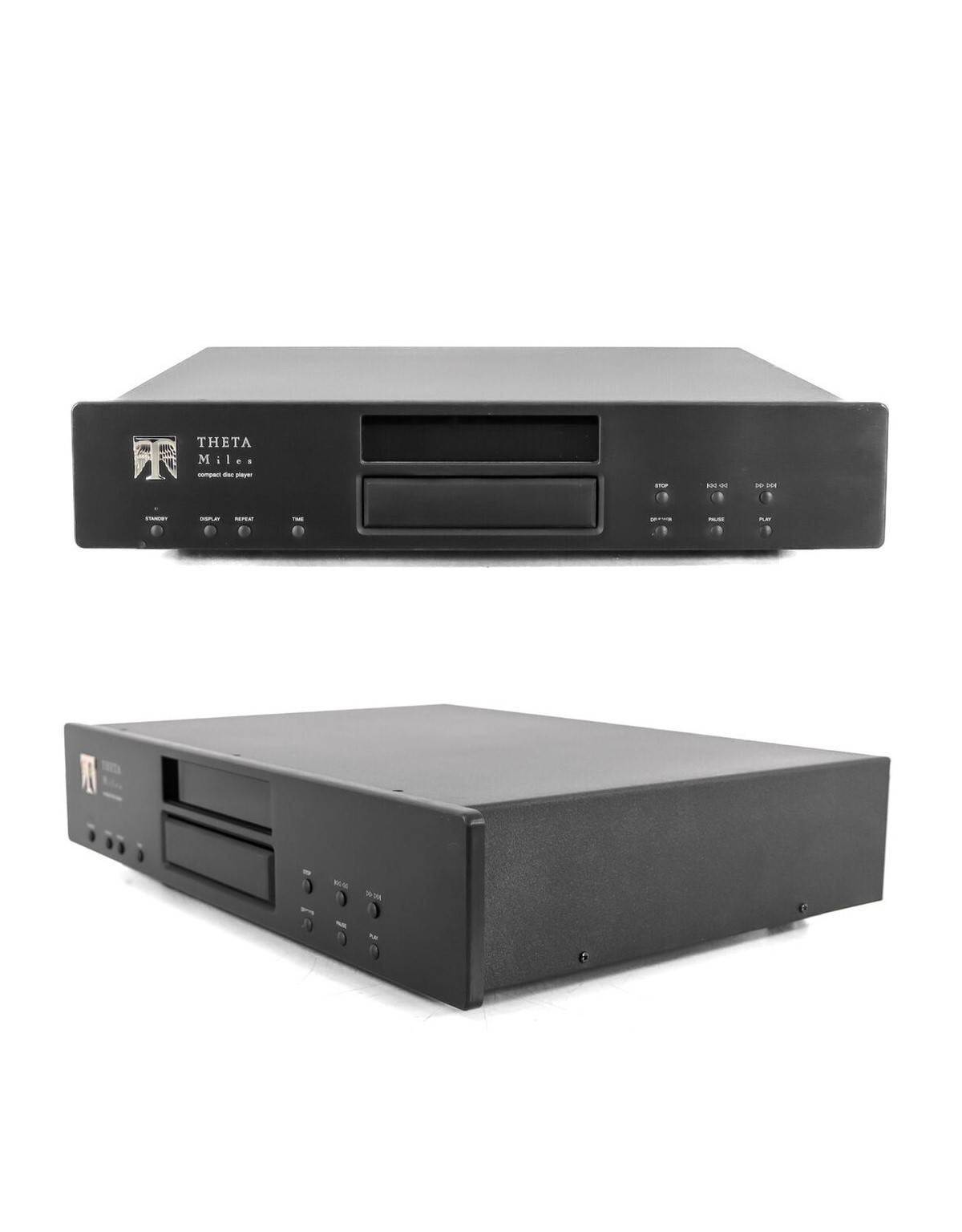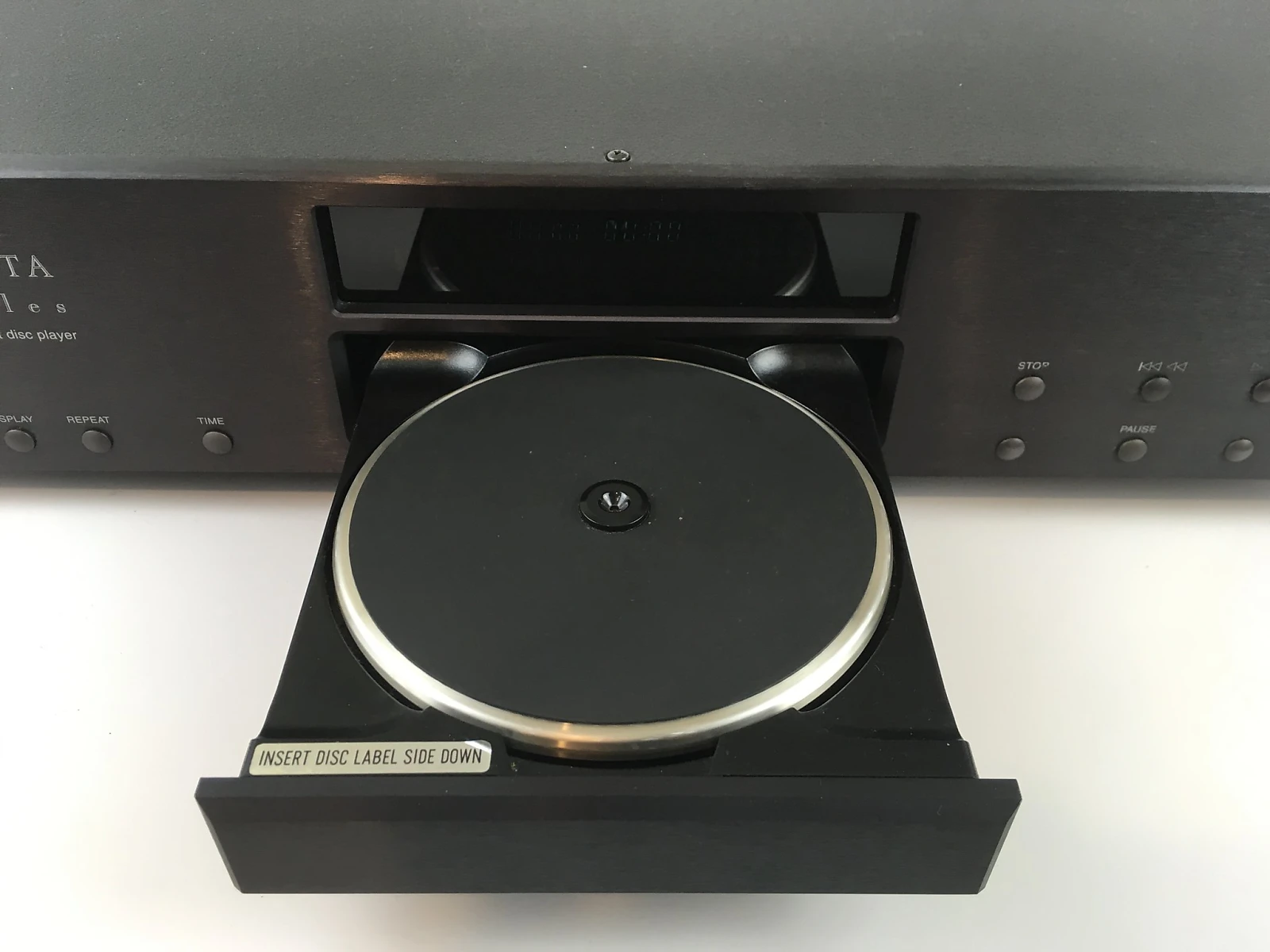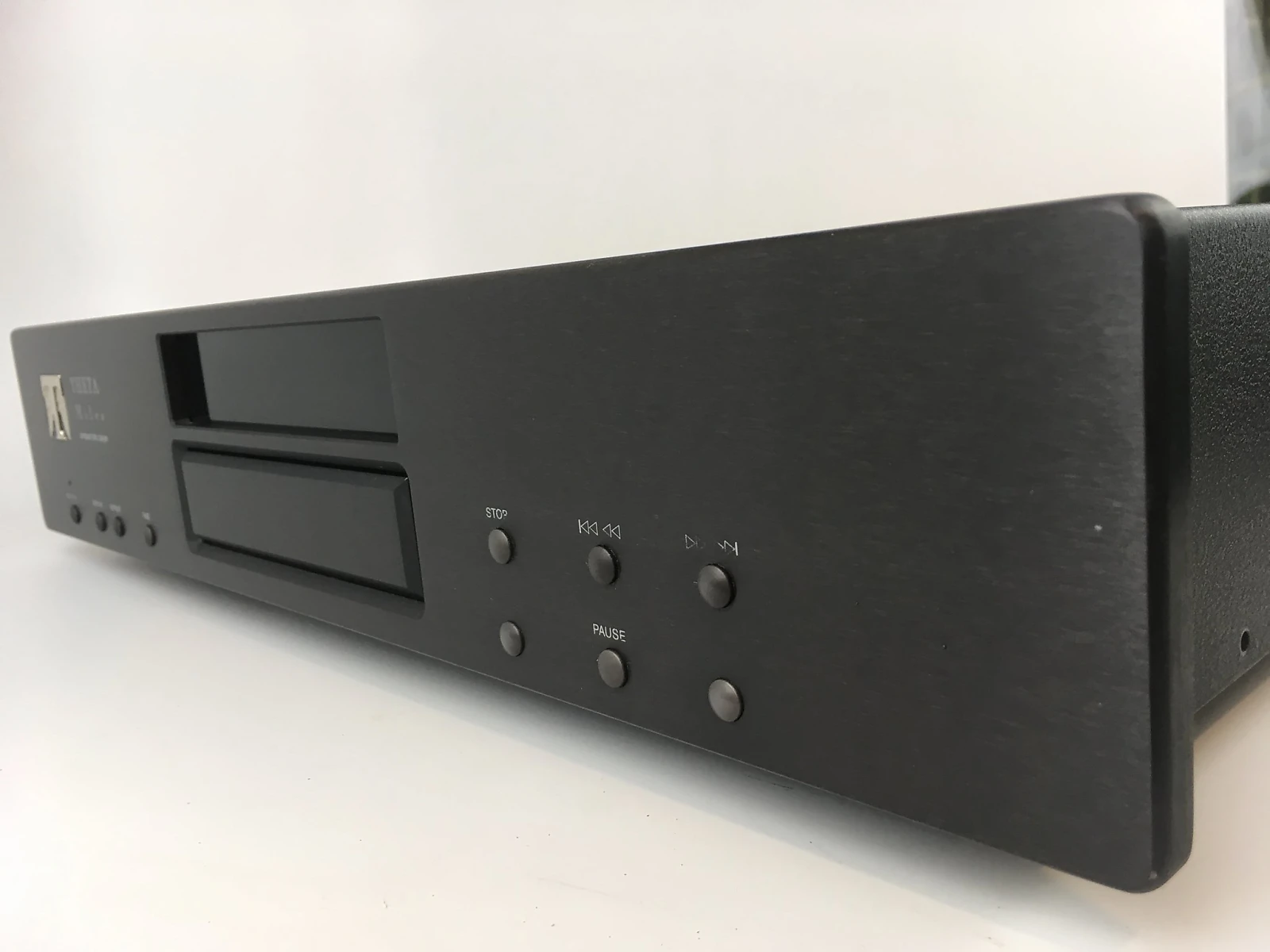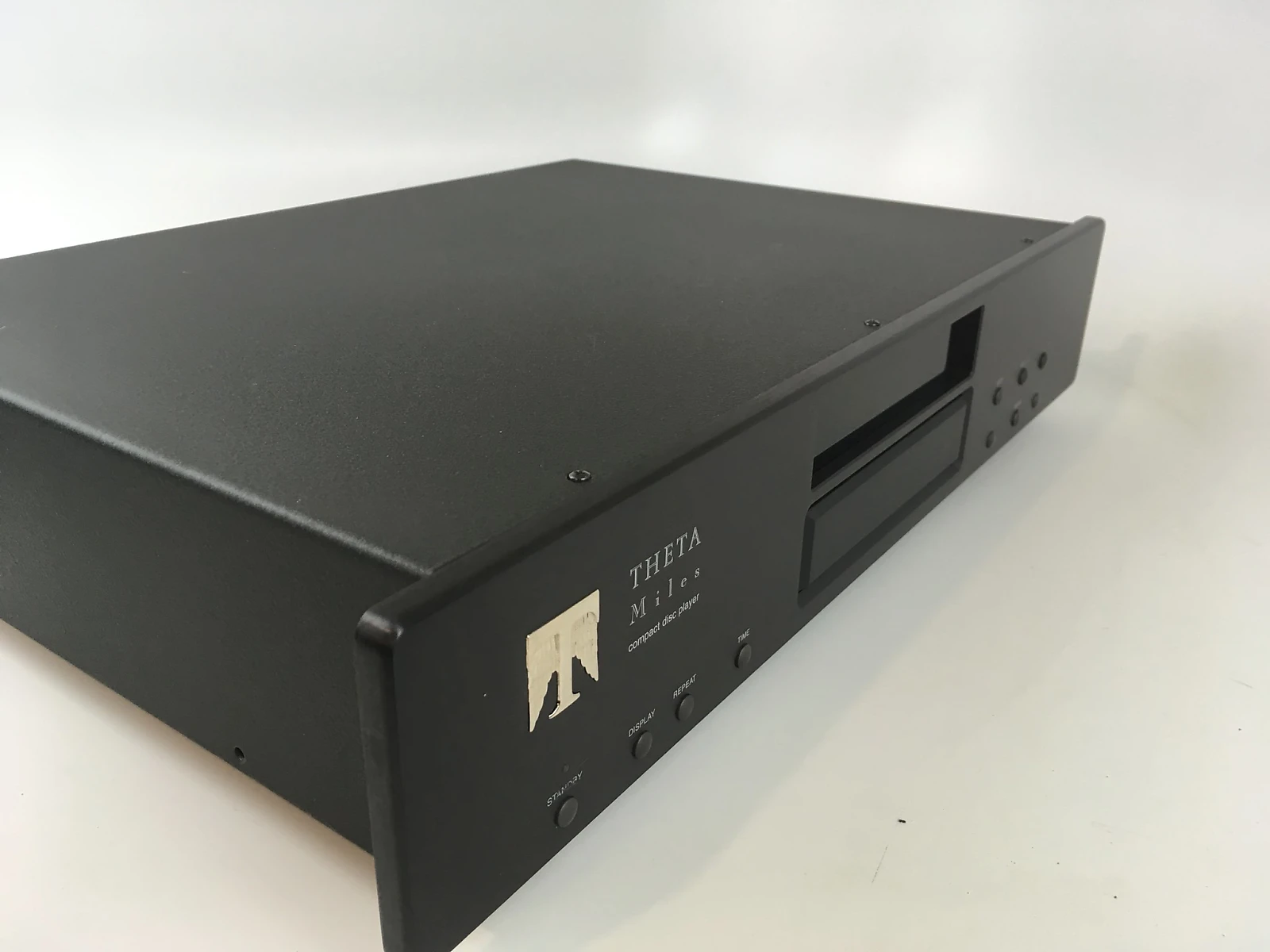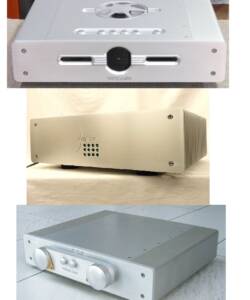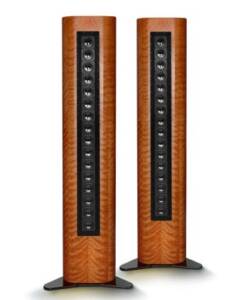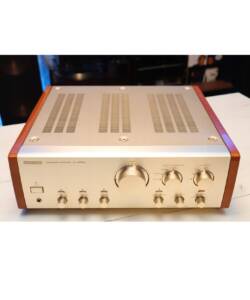Theta Miles CD Player
Original price was: R55,000.00.R7,400.00Current price is: R7,400.00.
A wonderful CD Player from the late 90’s featuring a very desirable inverted platter – said to provide the most stable platform possible for the CD laser.
You simply place the disc “label side down” into a solid steel platter, much like a record player.
Unit features a variable volume control allowing for very flexible installation, and a digital output in case you’d like to use a different DAC.
The analog output stage is based on the very expensive and coveted Casablanca unit, so it’s certainly no slouch.
This came to use us from the original owner who took good care of it, with only a few scuffs on the top panel. The front panel is free from nicks or dents, but the labels show some wear from use. The display is evenly lit and very legible.
Beautiful solid construction typical of all Theta pieces, with only the highest quality components used throughout. There are no less than 4 power supplies in this unit (!).
Includes the CD player, remote, and power cord.
Description
Theta Miles CD Player
by Todd Warnke
Do they know me or what?
You know the audio ad that asks if you considered naming your first-born Ringo, Wolfgang or Miles? Well, Robin and I long ago decided that if our first child is a boy, his name will be Miles (I lost the fight to name a girl Joni). Perhaps the folks over at Theta know about our deal, and that explains why I was chosen to review the Miles, Theta’s first single-box CD player. Or could it just be my recent good Kharma? Whatever the reason, the opportunity to listen to any Theta product is always enticing.
Since the introduction of the original DS Pro digital processor in 1989, Theta, with very few companions, has defined the leading edge of high-end digital. But what has served most to establish the Theta name is the company’s insistence on designing all their own digital filters. By taking control of this fundamental part of the conversion chain, Theta has learned much about the entire digital playback system, and been able to put that knowledge to use in proprietary, and upgradable, DACs. Use of their own filters also contributes to a distinctive and consistent house sound. Purchasing a Theta product, to a degree dependent upon the price, means that you own the Theta version of the digital truth. Traditionally, this has included full and dynamic bass, detailed treble, and impressive staging. In fact, impressive, rather than musical, has often been the tag on Theta gear. And while at one time that tag may have been right, recent Theta products have shown a tremendous balance of the impressive and musical. The Generation V-a DAC has, correctly to these ears, been called the best that digital is capable of. Yes, I’ve heard the big Levinson, Krell, ARC and Sonic Frontiers processors, but the Theta, to me, seems to extract maximum detail and musicality out of the current CD format.
The Miles, at $2095 in its single-ended version or $2595 with balanced output, is not a full-out assault on the state of the art like the Gen. V-a. Rather, it is meant to appeal to a large and significant niche in the market—those looking for near-state-of-the-art performance using trickle-down technology. To that end, Theta has built the Miles from successful products already in their line. Housed in a Pearl transport (a $1295 product), the chipset of the Miles is the same as that in the Pro Prime II-a DAC ($1495), and a filter based closely on the one used in the DS Pro Basic III-a DAC ($2695) is also part of the package.
Another feature of the Miles that helps it approach the state of the art is its built-in analog-domain variable attenuation. With the supplied remote, you can control the output of the Miles using 25 steps, each of which is slightly less than 3dB. This gives you control over a large volume window of near 75dB, but fine control is sacrificed. In my listening, with the player spending the majority of its time hooked directly to the amp, this did not cause a problem. I was able to find a reasonable volume level every time I sat down to listen, and the sound quality I got by bypassing the preamp was well worth any potential problems. By the way, the analog output is based on the output controller in the basic Theta Casablanca ($4595). As you can see, there are a lot of powerful trickle-down toys in this box.
As for looks, this player is beautiful, although in this case form seems to have won out over function in a couple of essential areas. The 1/4″-thick faceplate is a soft silver color and has an array of six buttons to the right of the stacked centrally located drive door and digital readout. To the left are four more buttons. Each of these buttons is large enough for use, but all are the same size, and the text or symbol to identify their purpose is small. In addition, their layout, at least to me, was not the easiest to memorize, nor the most logical. In the dark I found myself just hitting buttons until I got the result I wanted. The second ergonomic beef has to do with the remote itself. I don’t mind its size (small), nor the fact that it is a very light plastic wand, but what did get to me is that the buttons on it are all the same size and laid out in a grid that makes using the remote in the dark a matter of memorizing locations and then counting buttons by feel. I guess my complaints both have to do with listening in the dark, but since I do a lot listening that way, they stood out.
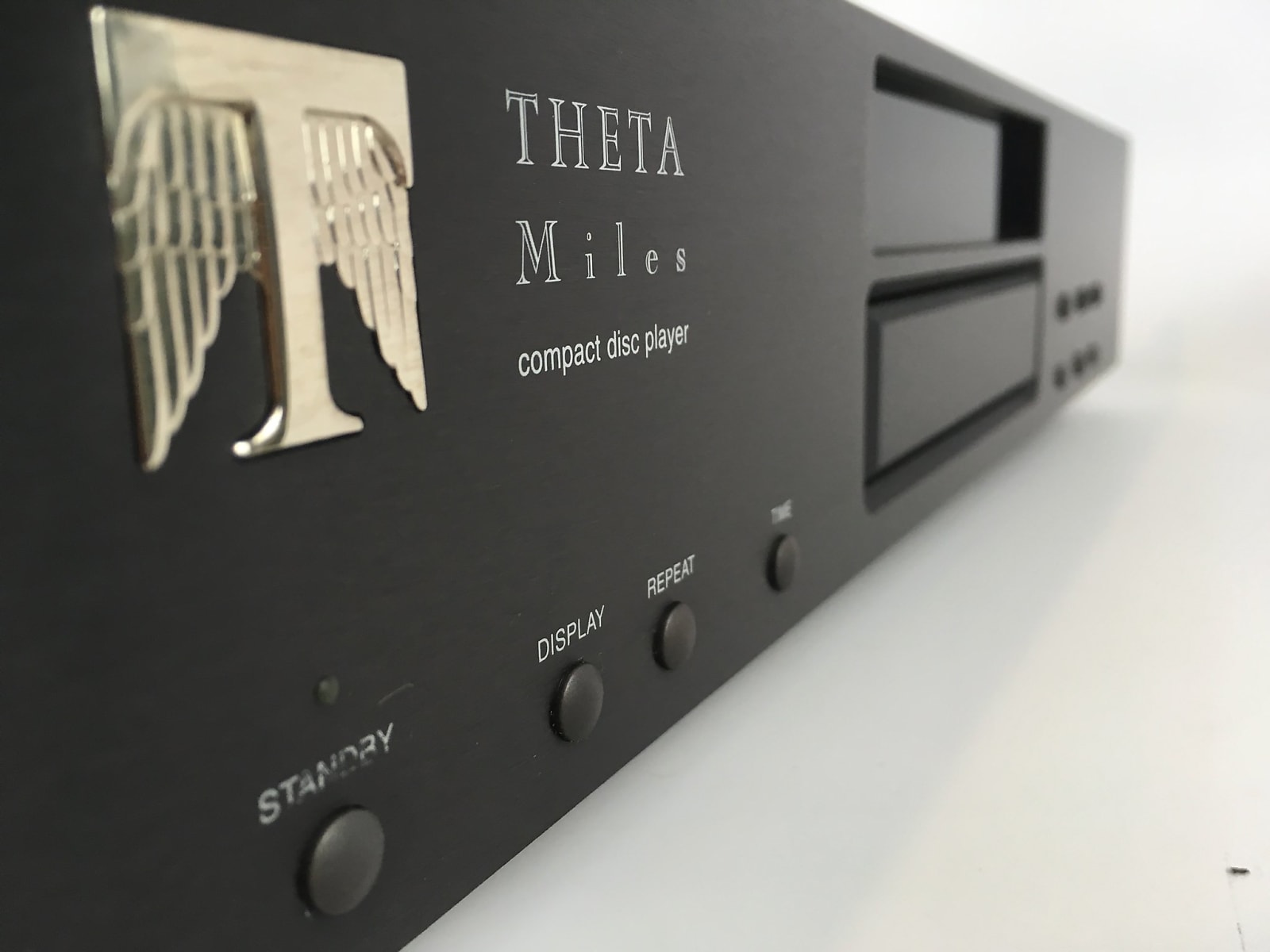
Ah, but do they know what I like in the dark?
The short answer is yes. But the long one, which is a bit more complicated, is also more revealing of the qualities of the Miles. The traditional Theta virtues—staging, bass extension, dynamics and detail—are all strong suits of the Miles.
Staging, and not just of the right/left type, but also of the front/back, layering type, is everything you’d expect. Compared to my fully tricked-out Audio Alchemy DDE 3.0 setup (JVC XL-Z1050 used as a transport, Ensemble Digiflux coax, AA DTI-Pro with PS3, Audio Magic Mystic Reference I2S cable, AA DDE 3.0 modded by Dusty Vawter with PS3, JPS Labs Digital power cords on both PS3s), I found that the stage was at least 20% wider and 30% deeper. In addition, that fine layering so prized by audiophiles was far more distinguishable. In musical terms, this meant that orchestral recordings had a greater believability, that I was able to cross the real/reproduction threshold with less effort and greater enjoyment.
As for the bottom end, as worn out as this line is, I heard bass lines and big drums with greater definition and nuance than ever before. In fact, in the office setup (Platinum Audio Studio 1 speakers, Symfonia Opus 10 amp warming up for review, JPS Labs speaker wire and Audio Magic interconnects) there was bass that had never been there before. As overheated as that sounds, it is the literal truth. In the main system (Dunlavy SC-III speakers, Blue Circle BC-6 amp, Nordost Red Dawn wiring, and on occasion Thor Audio TA-2000 preamp; everything with a cord plugged into an API Power Wedge 116 and all equipment on a SoundRack reference stand) bass lines extended by a handful of cycles, but more importantly, the Miles uncovered subtle bass detail that makes every bass line, regardless of how deep it is, more lifelike than what I heard with the DDE 3.0. This showed up with every recording, but an especially good example is “Private Investigations,” that old, artificial-but-fun chestnut of bass and imaging from the Dire Straits disc Love Over Gold (Warner Bros. 9 23728-2). With synth fills, deep bass lines and subterranean drums, this track will test every facet of bass reproduction. With the 3.0, bass was full, but compared to the Miles and to real life, it was slightly “plummy” and nondescript. The Theta player had drive and power, detail and extension. The difference was great enough that Ella, our Nipper look-alike, was only visibly spooked by the bass when the Miles was playing.
Dynamics were superb as well. Ella, our often unwilling participant in listening experiments, concurs. If you want to see real-life jump factor, combine the Miles, Ella and Steve Tibbetts’ The Fall of Us All (ECM 1527). While I’m not sure the SPCA will agree with my experiments, I can assure you that no animals were injured.
As for that final Theta virtue, detail, I can again report that the Miles preserved the family genes. One of my concerns about the Miles was that it is not HDCD compatible. My take on HDCD is that, while important, it’s too little too late. If it would have arrived three or four years earlier, it stood a chance, but with DVD-Audio, DAD and other parts of the alphabet soup still to come, too many people are willing to bypass HDCD and wait for the next wave. Still, Reprise just reissued the heart of the Joni Mitchell catalog in HDCD. I bought all of the new discs, and they are a definite step up from the standard-issue versions. When using the AA 3.0, I get the full HDCD treatment. Run side by side (for this test I used the Thor preamp and measured the output from each unit, getting the difference down to .02 of a volt; remember the Theta has an analog output control and the AA can be adjusted as well), I heard several spatial cues through the AA setup that I didn’t with the Miles, but all the tonal information was preserved. The differences were far less than I expected. In this case I don’t think that the HDCD encoding was the culprit; rather, the level of detail the Miles extracts is simply superb, and compared to the DDE 3.0, in another league altogether.

The Undiscovered Country
Now that I’ve covered, and discovered, what you expect from a Theta, let’s turn from those standard virtues and look at a new, and more important area, tonal accuracy.
Above all, I value tonal accuracy. Without that as a foundation, staging, detail, dynamics and extension are only academic exercises. And the Miles really does get to the tonal truth of recordings. I found that the timbral cues that separate, say, an English horn from an oboe were nicely and naturally presented. Another great example of the tonal accuracy of the Miles was the way it separated the voices of k.d. lang and Jane Siberry on “Calling All Angels” from Jane’s CD When I Was a Boy (Reprise 9 26824-2). Singing that’s in the same range and mixed to the center of the stage gives lesser players and DACs trouble, often leading to an interlacing of voices. The Miles separated the voices timbrally while blending them harmonically, just as it should be. With this as a solid base to build on, the traditional Theta virtues of staging, bass extension and dynamics are more than just audiophile jollies. They serve to enrich and reinforce the sensation of live music-making.
So, a rave, huh? Yes, but there is still a bit more to the story. While the tonal accuracy was as good or better than any player or DAC I’ve had in my room, harmonic accuracy was just ever so slightly thin in the mids. With some speaker/amp combinations, this was not bad. For example, when I first moved the Miles into the big room, it fed the Blue Circle BC-6, which was connected to the Kharma Ceramique 2.0 speakers with Cardas Hexlink 5-C cables. That setup tends, by a small amount, to drift to the rich side. The Theta was the perfect counterweight. It added detail and a sense of control to the system. On the other hand, when the Miles was used with the Densen Beat B-100 integrated and the Platinum Audio Studio 1s in the office setup, a clinical sound predominated.
A final listening point. Compared to the Theta DS Pro Basic III-a or especially the Gen. V-a, the Miles loses a bit of the ease and liquidity that the very best digital can reproduce. I don’t want to get into the whole analog-versus-digital debate here. Suffice it to say that I think both formats are flawed, and to nearly equal extents. I will also say that I don’t want my digital to do analog, or vice versa. Rather, what I’m talking about is that the musical flow the big Thetas have is here in the Miles too, but to a lesser degree. I’ve heard the Pro Prime II-a (which uses the same chipset as the Miles), and I find that the Miles has more flow and ease than that DAC does, but the Miles still falls slightly short of the DS Pro Basic III-a. My inference is that the filter used in both the Miles and the DS Pro Basic III-a contributes greatly to the ease, but that the Miles is still saddled with the chipset from the Pro Prime II-a. Still, for what could be considered a transport/DAC combo that costs the same as the standalone III-a DAC, the Miles gets oh so close to the same lofty clime.
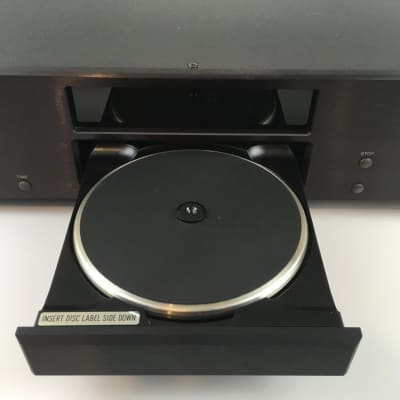
A Pearl Too?
One of the ways to think about the Miles is to look at it as a roughly $2100 Theta DAC—the Pro Prime II-a chipset at $1495 with the filter from and nearly the performance of the $2695 DS Pro Basic III-a—with a free Pearl transport. The fact that the DAC and transport are in the same chassis saves you from having to buy an anti-jitter box and two cables as well. Along this line, I did use the Miles as a transport on several occasions. For example, when comparing the Miles and the DDE 3.0, I used the coax output on the Miles to drive the AA DAC. In this mode, the performance of the Miles was everything you’d expect from a Theta transport: detailed, deep, and stable. The images and music with the Miles as transport were of a distinctly better class than what I heard using my JVC player in the same way. I used to think, more with hopefulness than logic, that an anti-jitter box would eliminate transport differences. Not so. Even through the DTI-Pro, the Miles was a better transport than the JVC. How much better? I’m not a transport aficionado, but the difference was not subtle and was enough to recommend the Miles as a transport alone. Of course, with the Pearl available, buying the Miles to use as a transport would be silly, wouldn’t it?
Final Words?
How do I wrap this up? I think I already used the right conclusion in the previous paragraph. The Miles is a near clone of the Basic III-a with a free transport thrown in. Not a bad deal. This is truly a case of trickle-down technology at work. I advise you to check out the Miles, and quickly. Once Theta realizes what a deal they’re giving you, they’ll have to up the price!
